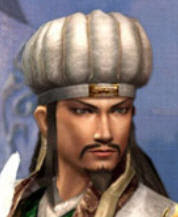Romance of the Three Kingdoms - Part IX
The Battle of Jieqiao: 瞞天過海 Deceive the Heavens to Cross the Ocean
It was the year AD200. With a massive 100,000 infantry and over 10,000 cavalry, Yuan Shao commanded the largest military force in all of China at this time. Flanked with valiant warriors including Wen Chou and Yan Liang and able strategists such as Tian Feng and Ju Shou, his forces appeared unstoppable. Further, he was in possession of vast provinces in Northern China including Jizhou, Qingzhou, Youzhou, and Bingzhou.
The Grand Administrator of Bohai
Who was Yuan Shao? In this post we shall trace his roots and his rise to power in Northern China.
Prior to the fall of the Han Empire, the Yuan family had held the highest offices of state for generations and their network of allies and clients extended across the empire. Thus, Yuan Shao held immense authority and prestige.
As the leader of the Guandong Coalition, Yuan Shao commanded the most famous warlords of his time. Unfortunately, due to bickering and squabbling between the various factions, the Coalition failed in their attempt to defeat Dong Zhuo and restore the Han Empire.
Battle of Jieqiao (Source: Wikipedia)
The Time: AD191
The Place: Jieqiao
The Rivals: Yuan Shao vs. Gongsun Zan
With the Coalition in tatters, Yuan Shao retreated back to his city at Ye and began building a warlord state. In AD191, Han Fu, the Governor of Ji province surrendered his governorship to Yuan Shao in light of an imminent attack by Gongsun Zan from the North. In the winter of that year, the two forces met at the Jieqiao. It was at this battle that Yuan Shao laid the foundations of his kingdom.
Yuan Shao himself came in force and the two sides met 40km south of Jie Bridge, a crossing on the Qing River. Gongsun Zan's army had a reported strength of 40,000, consisting of 30,000 infantry and 10,000 calvalry. He arrayed his infantry in a square and divided his cavalry between the left and right wings. In the centre were placed his elite Baima Calvalry which formed the core of his fighting force.
Though Yuan Shao's army was of comparable size, it consisted almost entirely of infantry. His commander Qu Yi was placed at the van with 800 elite troops and 1,000 crossbowmen. Behind them stood masses of footsoldiers, numbering in the tens of thousands, commanded by Yuan Shao himself.
Stratagem: 瞞天過海 Deceive the Heavens to Cross the Ocean
Yuan Shao realized that the Gongsun Zan’s forces were overly dependent on its’ elite Baima Calvalry ‘whose flags and armour lit up Heaven and Earth’. If this elite unit could be defeated, Gongsun Zan’s forces would be demoralized and unable to withstand a counterattack by Yuan Shao’s infantry.
Yuan Shao then purposely misled Gongsun Zan into believing that his vanguard was thinly spread. As an experienced horseman, Gongsun Zan ordered a charge by his cavalry expecting to break the enemy line and destroy the core of Yuan Shao’s army forcing them to retreat.
However, Yuan Shao’s men were well prepared. His infantry formed a shield wall and awaited the onslaught. When Gongsun Zan's cavalry was a mere ten paces away, the crossbowmen loosed waves of bolts, followed by the footsoldiers, who rose with their spears. After a general melée the front of Yuan Shao's line was littered with cut down horses and Gongsun Zan's dead.
The Gongsun commander, Yan Gang was killed in the fighting. Yuan Shao's army is said to have taken 1,000 heads. Having failed to breach the Yuan line, the Gongsun cavalry wheeled around and fled from the battle, followed by the infantry.
Gongsun Zan attempted to regroup and hold the line of the Qing River. His rearguard clashed with Yuan Shao’s forces at Jie Bridge but was defeated. The abandoned Gongsun camp was quickly overrun.
Conclusion:
The Battle of Jieqiao halted the southern advance of Gongsun Zan but it was by no means decisive in the protracted struggle between Gongsun Zan and Yuan Shao. These two rivals would meet once again in AD199 at Yijing for a final decisive encounter.








5 comments:
The part about "Deceive the Heavens to Cross the Ocean" has a modern application.
Today's stealth bombers appear invisible to radar (deceive the heavens) as they cross the oceans to bomb faraway targets. We can also use deception via trojans, easter eggs, etc. to attack national infrastructures through cyberspace.
Thru the ages, humans believe in achieving peace through war. We always want peace, that's why we're always at war.
Dear Damien,
So long as the three roots of greed, hatred and delusion exists, there will always be wars.
Most [if not all] these stratagems would continue to have modern applications. Why? Because although our technologies have improved tremendously, we humans have not.
Rgds
Damien : & to counter all that high tech devastation, extremists finally decided to take a page from Hollywood & directed with leadin' roles in the most epic televised devastation of the globalized age - 9/11...
Dear YT,
Indeed. This is a very disturbing trend. Let's hope no one else gives them any more bright ideas.
A scenario like '28 Days Later' really gives me nightmares!
Rgds
Avatar : ingenuity ALWAYS triumphs over lack of imagination.
Post a Comment